
The Nigerian Dwarf is an American breed of dwarf goat. Like the American Pygmy Goat, it derives from the West African Dwarf group of breeds of West Africa.

The Bagot goat is a breed of goat which for several hundred years has lived semi-wild at Blithfield Hall, Staffordshire, England.

Goat milk is the milk of domestic goats.
BioSteel was a trademark name for a high-strength fiber-based material made of the recombinant spider silk-like protein extracted from the milk of transgenic goats, made by Montreal-based company Nexia Biotechnologies, and later by the Randy Lewis lab of the University of Wyoming and Utah State University. It is reportedly 7-10 times as strong as steel if compared for the same weight, and can stretch up to 20 times its unaltered size without losing its strength properties. It also has very high resistance to extreme temperatures, not losing any of its properties within −20 to 330 degrees Celsius.
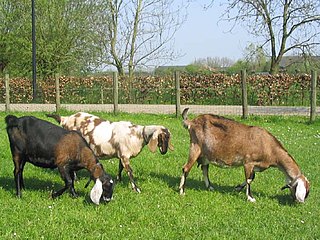
The Anglo-Nubian is a British breed of domestic goat. It originated in the nineteenth century from cross-breeding between native British goats and a mixed population of large lop-eared goats imported from India, the Middle East and North Africa. It is characterised by large, pendulous ears and a convex profile. It has been exported to many parts of the world, and is found in more than sixty countries. In many of them it is known simply as the Nubian.
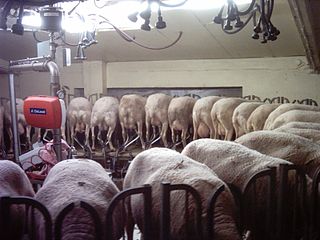
Sheep's milk is the milk of domestic sheep. It is commonly used to make cultured dairy products such as cheese. Some of the most popular sheep cheeses include feta (Greece), ricotta (Italy), and Roquefort (France).

The Golden Guernsey is a rare breed of dairy goat from Guernsey in the Channel Islands, where it has been known for more than two hundred years.

Sheep are quadrupedal, ruminant mammals typically kept as livestock. Like all ruminants, sheep are members of the order Artiodactyla, the even-toed ungulates. Although the name sheep applies to many species in the genus Ovis, in everyday usage it almost always refers to Ovis aries. Numbering a little over one billion, domestic sheep are also the most numerous species of sheep. An adult female is referred to as a ewe, an intact male as a ram, occasionally a tup, a castrated male as a wether, and a young sheep as a lamb.

The domestic goat or simply goat is a subspecies of C. aegagrus domesticated from the wild goat of Southwest Asia and Eastern Europe. The goat is a member of the animal family Bovidae and the subfamily Caprinae, meaning it is closely related to the sheep. There are over 300 distinct breeds of goat. It is one of the oldest domesticated species of animal, according to archaeological evidence that its earliest domestication occurred in Iran at 10,000 calibrated calendar years ago.

The Alpine is a medium to large sized breed of domestic goat known for its very good milking ability. They have no set colours or markings. They have horns, a straight profile and erect ears.
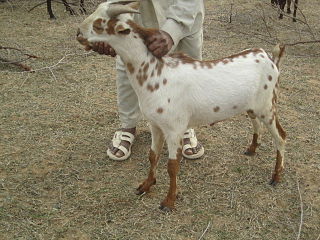
The Barbari or Bari is a breed of small domestic goat found in a wide area in India and Pakistan. It is distributed in the states of Haryana, Punjab and Uttar Pradesh in India, and in Punjab and Sindh provinces of Pakistan.
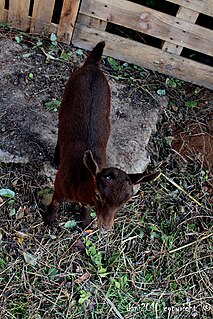
The Murciano-Granadina is a Spanish breed of dairy goat. It was created in 1975 when two existing breeds, the mahogany-coloured Murciana of Murcia and the black Granadina of Granada, began to be hybridised as a result of the official recognition of a single herdbook including both breeds. It is the most important dairy goat breed of Spain, with more than 500,000 milking females. It originated in the semi arid areas in south eastern Spain, including parts of Murcia, Almería, Granada and Alicante. They were bred for two main traits, milk production and its ability to continue this production in dry and nutrient poor regions. They have been introduced into several areas in Latin America as well as northern Africa.

The Poitou goat is a dairy goat breed from western France. With a history dating back to 1800, the breed is named for the Poitou historic province. Poitou goats are known for their use in goat milk cheese production, though they are an endangered breed, and at one point were down to just 600 breeding animals. Poitou goats have a distinctive appearance: tall and with long, shaggy hair, they are black-brown with white marks on the head and neck, while the underbelly and legs are white.
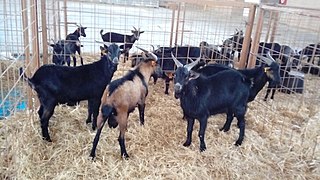
The Verata is a traditional Spanish breed of domestic goat. It is a dual-purpose breed, reared both for its meat and for its milk. It is named for, and is thought to originate in, the comarca of La Vera, in the province of Cáceres, in the northern part of the autonomous community of Extremadura in western central Spain. It is one of two traditional goat breeds in Extremadura, the other being the Retinta Extremeña.
The British Milksheep is a robust, dual-purpose sheep commonly known for its milking characteristics.

American Lamancha, or more commonly, simply Lamancha or LaMancha, is a formally recognized breed of dairy goat, first bred in California by Mrs. Eula Fay Frey about 1927. Later she moved the herd to Glide, Oregon for further development. The Lamancha goat is a member of the Capra genus, specifically Capra aegagrus hircus, like all domestic goats.
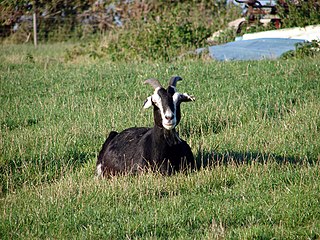
The British Alpine goat is a breed of domestic goat developed in the early 1900s. A standard British Alpine goat is black all over with white 'Swiss' markings. Another well-known breed that has these markings is the Toggenburg goat, and the breed was developed from the Toggenburg, native British goats, and Nubian genetics. The British Alpine is a high producer of quality goats' milk, and the breed can be found in many goat dairies as an acceptable milker. These goats are capable of extended lactations, sometimes even lasting close to two years.

Agriculture in Somalia is a major employment activity and is the largest economic sector in the country. It contributes more than 65% to the national GDP from domestic distribution and exports to other parts of the continent, the Middle East and Europe.
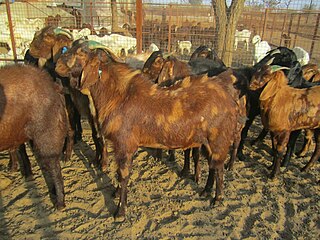
The Sirohi is an Indian breed of domestic goat. It is named for its area of origin, the Sirohi District of Rajasthan, in north-western India. It may be described as a dual-purpose breed, reared for both meat and milk production, or as meat breed. It is well adapted to the dry tropical climate of Rajasthan.
The Aspromonte or Capra dell'Aspromonte is an indigenous breed of domestic goat from the mountain massif of the Aspromonte, in the province of Reggio Calabria in Calabria in southern Italy, for which it is named. It is raised only in the province of Reggio Calabria, mainly in the Aspromonte, in the Altipiano dello Zomaro to the north-east, and in the Ionian coastal areas of the province, and particularly in areas of Grecanic culture. While the breed is thought to originate on the Aspromonte, it may have been influenced by the various other goat breeds, including the Abyssinian goat, the Maltese, and a type known as "Tibetan" with long silky hair, whose importation to Calabria in the early twentieth century is well documented.

















